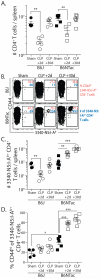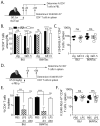Gut Microbial Membership Modulates CD4 T Cell Reconstitution and Function after Sepsis
- PMID: 27448587
- PMCID: PMC4992581
- DOI: 10.4049/jimmunol.1600940
Gut Microbial Membership Modulates CD4 T Cell Reconstitution and Function after Sepsis
Abstract
Transient lymphopenia is one hallmark of sepsis, and emergent data indicate the CD4 T cell compartment in sepsis survivors is numerically and functionally altered (when examined at the Ag-specific level) compared with nonseptic control subjects. Previous data from our laboratory demonstrated Ag-independent, lymphopenia-induced homeostatic proliferation to be a contributing mechanism by which CD4 T cells numerically recover in sepsis survivors. However, we reasoned it is also formally possible that some CD4 T cells respond directly to Ag expressed by gut-resident microbes released during polymicrobial sepsis. The effect of gut microbiome leakage on CD4 T cells is currently unknown. In this study, we explored the number and function of endogenous CD4 T cells specific for segmented filamentous bacterium (SFB) after cecal ligation and puncture (CLP)-induced sepsis using mice that either contained or lacked SFB as a normal gut-resident microbe. Interestingly, SFB-specific CD4 T cells underwent Ag-driven proliferation in CLP-treated SFB(+), but not in SFB(-), mice. Moreover, CLP-treated SFB(+) mice showed resistance to secondary lethal infection with recombinant SFB Ag-expressing virulent Listeria (but not wild-type virulent Listeria), suggesting the CLP-induced polymicrobial sepsis primed for a protective response by the SFB-specific CD4 T cells. Thus, our data demonstrate that the numerical recovery and functional responsiveness of Ag-specific CD4 T cells in sepsis survivors is, in part, modulated by the intestinal barrier's health discreetly defined by individual bacterial populations of the host's microbiome.
Copyright © 2016 by The American Association of Immunologists, Inc.
Figures






Similar articles
-
Polymicrobial Sepsis Impairs Antigen-Specific Memory CD4 T Cell-Mediated Immunity.Front Immunol. 2020 Aug 12;11:1786. doi: 10.3389/fimmu.2020.01786. eCollection 2020. Front Immunol. 2020. PMID: 32903436 Free PMC article.
-
Constitutive Vagus Nerve Activation Modulates Immune Suppression in Sepsis Survivors.Front Immunol. 2018 Sep 6;9:2032. doi: 10.3389/fimmu.2018.02032. eCollection 2018. Front Immunol. 2018. PMID: 30237803 Free PMC article.
-
Polymicrobial Sepsis Chronic Immunoparalysis Is Defined by Diminished Ag-Specific T Cell-Dependent B Cell Responses.Front Immunol. 2018 Oct 31;9:2532. doi: 10.3389/fimmu.2018.02532. eCollection 2018. Front Immunol. 2018. PMID: 30429857 Free PMC article.
-
Enteric immunity, the gut microbiome, and sepsis: Rethinking the germ theory of disease.Exp Biol Med (Maywood). 2017 Jan;242(2):127-139. doi: 10.1177/1535370216669610. Epub 2016 Oct 4. Exp Biol Med (Maywood). 2017. PMID: 27633573 Free PMC article. Review.
-
Can the Cecal Ligation and Puncture Model Be Repurposed To Better Inform Therapy in Human Sepsis?Infect Immun. 2020 Aug 19;88(9):e00942-19. doi: 10.1128/IAI.00942-19. Print 2020 Aug 19. Infect Immun. 2020. PMID: 32571986 Free PMC article. Review.
Cited by
-
Claudin-2 upregulation enhances intestinal permeability, immune activation, dysbiosis, and mortality in sepsis.Proc Natl Acad Sci U S A. 2024 Mar 5;121(10):e2217877121. doi: 10.1073/pnas.2217877121. Epub 2024 Feb 27. Proc Natl Acad Sci U S A. 2024. PMID: 38412124 Free PMC article.
-
Sepsis impedes EAE disease development and diminishes autoantigen-specific naive CD4 T cells.Elife. 2020 Nov 16;9:e55800. doi: 10.7554/eLife.55800. Elife. 2020. PMID: 33191915 Free PMC article.
-
A bibliometric analysis of the role of microbiota in trauma.Front Microbiol. 2023 Feb 2;14:1091060. doi: 10.3389/fmicb.2023.1091060. eCollection 2023. Front Microbiol. 2023. PMID: 36819034 Free PMC article.
-
Huashibaidu formula attenuates sepsis-induced acute lung injury via suppressing cytokine storm: Implications for treatment of COVID-19.Phytomedicine. 2023 Jan;109:154549. doi: 10.1016/j.phymed.2022.154549. Epub 2022 Nov 19. Phytomedicine. 2023. PMID: 36610129 Free PMC article.
-
Polymicrobial sepsis impairs bystander recruitment of effector cells to infected skin despite optimal sensing and alarming function of skin resident memory CD8 T cells.PLoS Pathog. 2017 Sep 14;13(9):e1006569. doi: 10.1371/journal.ppat.1006569. eCollection 2017 Sep. PLoS Pathog. 2017. PMID: 28910403 Free PMC article.
References
-
- Shankar-Hari M, Phillips GS, Levy ML, Seymour CW, Liu VX, Deutschman CS, Angus DC, Rubenfeld GD, Singer M, F. Sepsis Definitions Task Developing a New Definition and Assessing New Clinical Criteria for Septic Shock: For the Third International Consensus Definitions for Sepsis and Septic Shock (Sepsis-3) JAMA. 2016;315:775–787. - PMC - PubMed
-
- Vulliamy PE, Perkins ZB, Brohi K, Manson J. Persistent lymphopenia is an independent predictor of mortality in critically ill emergency general surgical patients. Eur. J. Trauma Emerg. Surg. 2015 - PubMed
-
- Hamers L, Kox M, Pickkers P. Sepsis-induced immunoparalysis: mechanisms, markers, and treatment options. Minerva Anestesiol. 2015;81:426–439. - PubMed
-
- Hotchkiss RS, Tinsley KW, Swanson PE, Schmieg RE, Jr., Hui JJ, Chang KC, Osborne DF, Freeman BD, Cobb JP, Buchman TG, Karl IE. Sepsis-induced apoptosis causes progressive profound depletion of B and CD4+ T lymphocytes in humans. J. Immunol. 2001;166:6952–6963. - PubMed
Publication types
MeSH terms
Substances
Grants and funding
LinkOut - more resources
Full Text Sources
Other Literature Sources
Medical
Research Materials
Miscellaneous

